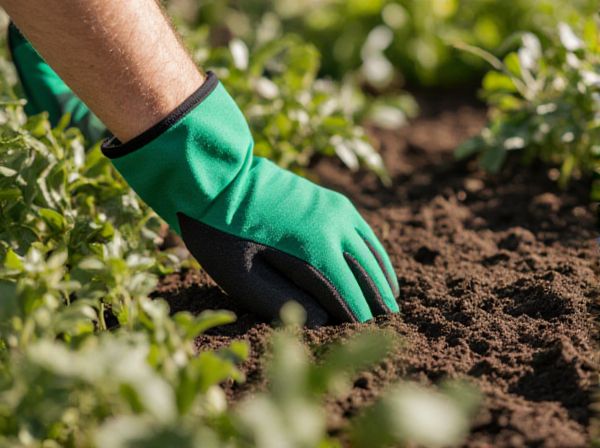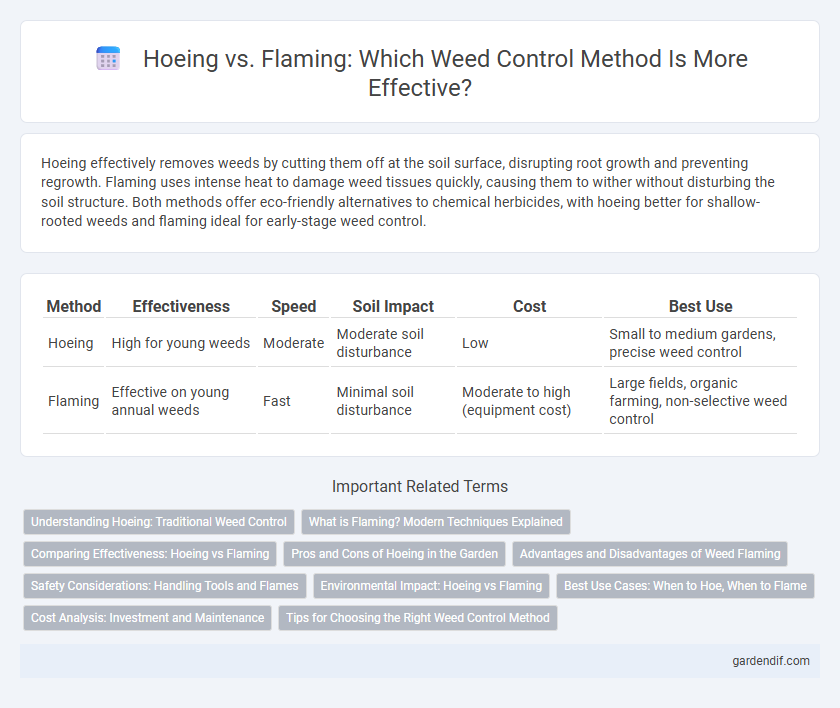
Hoeing vs Flaming Illustration
Hoeing effectively removes weeds by cutting them off at the soil surface, disrupting root growth and preventing regrowth. Flaming uses intense heat to damage weed tissues quickly, causing them to wither without disturbing the soil structure. Both methods offer eco-friendly alternatives to chemical herbicides, with hoeing better for shallow-rooted weeds and flaming ideal for early-stage weed control.
Table of Comparison
| Method | Effectiveness | Speed | Soil Impact | Cost | Best Use |
|---|---|---|---|---|---|
| Hoeing | High for young weeds | Moderate | Moderate soil disturbance | Low | Small to medium gardens, precise weed control |
| Flaming | Effective on young annual weeds | Fast | Minimal soil disturbance | Moderate to high (equipment cost) | Large fields, organic farming, non-selective weed control |
Understanding Hoeing: Traditional Weed Control
Hoeing is a traditional weed control method involving manual or mechanical uprooting of weeds by cutting them just below the soil surface, disrupting their root systems to prevent regrowth. This technique is effective for managing young weed seedlings in vegetable gardens and row crops, minimizing herbicide use and soil disturbance. Proper timing and consistent hoeing significantly enhance weed suppression and improve crop health by reducing competition for nutrients and water.
What is Flaming? Modern Techniques Explained
Flaming is a modern weed control technique that uses high-temperature gas flames to destroy weed tissues without chemicals. This method targets the plant cells by rapidly heating them, causing cell rupture and plant death, making it effective for organic farming. Advanced flamers feature adjustable flame intensity and propane gas systems for precise application, ensuring minimal soil disturbance and preserving beneficial organisms.
Comparing Effectiveness: Hoeing vs Flaming
Hoeing physically cuts weeds at soil level, providing immediate removal and disrupting root growth, making it highly effective for established and larger weeds. Flaming uses intense heat to damage weed cells, effectively controlling young, small weeds before they develop deep roots, but may require repeated applications for persistent species. Both methods reduce weed competition without chemicals, with hoeing offering precision and flaming covering larger areas quickly, depending on the weed type and growth stage.
Pros and Cons of Hoeing in the Garden
Hoeing in the garden effectively controls weeds by cutting them off just below the soil surface, reducing competition for nutrients and water. It is a cost-efficient method that improves soil aeration and promotes plant growth but requires regular labor and careful timing to avoid damaging plant roots. However, hoeing may not be effective against deeply rooted or perennial weeds and can cause soil disturbance that increases erosion risks.
Advantages and Disadvantages of Weed Flaming
Weed flaming offers advantages such as rapid weed death, reduced soil disturbance, and minimal chemical use, making it environmentally friendly and ideal for organic farming. Disadvantages include limited effectiveness on perennial weeds with deep roots, potential crop damage if not carefully controlled, and an initial investment in specialized equipment. Effective flame weeding requires precise timing and operator skill to maximize weed control while preserving desirable plants.
Safety Considerations: Handling Tools and Flames
Hoeing requires careful handling of sharp blades to avoid cuts and wrist strain, making protective gloves and proper posture essential for safety. Flaming demands strict precautions due to open flames, including using flame-resistant gloves, ensuring no nearby flammable materials, and maintaining a steady distance to prevent burns or uncontrolled fires. Both methods benefit from thorough training on equipment use and emergency procedures to minimize accidents during weed control.
Environmental Impact: Hoeing vs Flaming
Hoeing minimizes chemical use by mechanically removing weeds, preserving soil health and reducing pollution. Flaming targets weed seedlings with intense heat, but repeated use can harm beneficial soil microorganisms and increase carbon emissions. Choosing between hoeing and flaming depends on balancing immediate weed control needs with long-term environmental sustainability.
Best Use Cases: When to Hoe, When to Flame
Hoeing is ideal for young, shallow-rooted weeds in small garden beds, efficiently disrupting weed seedlings before they establish. Flaming works best in larger, established areas with hardier, surface-level weeds, using controlled heat to damage weed cells without disturbing soil structure. Choosing between hoeing and flaming depends on weed type, growth stage, and garden size, ensuring targeted, effective weed control.
Cost Analysis: Investment and Maintenance
Hoeing requires initial investment in manual or motorized tools, with relatively low ongoing maintenance costs, making it a cost-effective option for small-scale weed control. Flaming demands purchasing specialized equipment like propane torches and fuel, which results in higher upfront and recurring expenses due to propane consumption and equipment upkeep. Cost analysis must consider field size, intensity of weed pressure, and labor availability to determine the most economical and efficient weed management strategy.
Tips for Choosing the Right Weed Control Method
Hoeing is ideal for small gardens and early-stage weed control, allowing precise removal of weeds close to desired plants, while flaming effectively targets large areas and stubborn perennial weeds by using intense heat to destroy weed tissues. Consider soil type, moisture levels, and plant sensitivity when choosing between mechanical hoeing and thermal flaming to avoid damaging crops or beneficial organisms. For optimal weed management, combine hoeing for young, shallow-rooted weeds and flaming for larger, tougher weeds, paying close attention to weather conditions and timing to maximize effectiveness.
Hoeing vs Flaming Infographic

 gardendif.com
gardendif.com